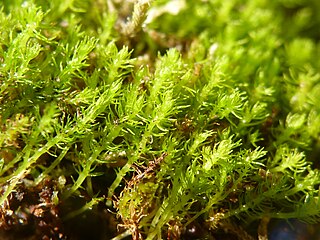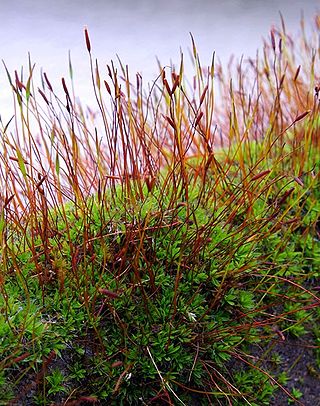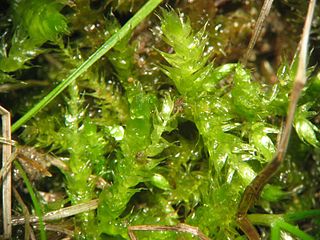Harold Ernest Robinson was an American botanist and entomologist.

Takakia is a genus of two species of mosses known from western North America and central and eastern Asia. The genus is placed as a separate family, order and class among the mosses. It has had a history of uncertain placement, but the discovery of sporophytes clearly of the moss-type firmly supports placement with the mosses.

Meesia uliginosa, the broad-nerved hump-moss, is a rare moss of the Western U.S. It occurs all around the northern hemisphere in higher latitudes, and in some places is not as rare as in the Western U.S.
Gradsteinia is a genus of moss in family Amblystegiaceae.
Merrilliobryum is a genus of moss in family Fabroniaceae. The genus is found in New Guinea and the Philippines.
Ochyraea is a genus of moss in the family Amblystegiaceae.
Skottsbergia is a monotypic genus, of haplolepideous mosses (Dicranidae) in the family Ditrichaceae containing the single species Skottsbergia paradoxa. It is endemic to Argentina, where it is an endangered species known from just a few locations. It occurs in the southernmost parts of Argentina, growing on South Georgia and Isla Grande de Tierra del Fuego in boggy habitat.
Neosharpiella is a genus of moss containing two species in the family Bartramiaceae. The type species, Neosharpiella aztecorum, grows in alpine regions of central Mexico, while the other species, Neosharpiella turgida, has been found in Bolivia and Ecuador.

Grimmia is a genus of mosses (Bryophyta), originally named by Jakob Friedrich Ehrhart in honour of Johann Friedrich Carl Grimm, a physician and botanist from Gotha, Germany.
Ryszard Ochyra is a Polish bryologist. This botanist is denoted by the author abbreviation Ochyra when citing a botanical name.
Leopold Loeske was a German watchmaker and amateur bryologist.

Racomitrium lanuginosum is a widespread species of moss found in montane and arctic tundra, the genus Racomitrium is found across the Northern and Southern hemispheres., however Racomitrium lanuginosum is only found in the Northern hemisphere. It grows as large mats on exposed rock and in boulder scree, particularly on acidic rocks. Its leaves have a characteristically decurrent and toothed hair-point, which gives rise to its regional common names woolly fringemoss, hoary rock-moss and woolly moss.

Racomitrium is a genus of mosses in the family Grimmiaceae established in 1818 by Samuel Elisée Bridel-Brideri. It contains the following species:

Grimmiaceae is a family of mosses in the order Grimmiales.

Schistidium is a plant genus in the moss family Grimmiaceae.

Tortula is a genus of mosses in the family Pottiaceae.
Bucklandiella elegans is a species of moss in the family Grimmiaceae. It is found in New Zealand.

Brachytheciaceae is a family of mosses from the order Hypnales. The family includes over 40 genera and 250 species.

Kindbergia is a genus of mosses belonging to the family Brachytheciaceae.
Sanionia is a genus of mosses belonging to the family Amblystegiaceae.









